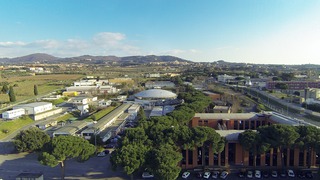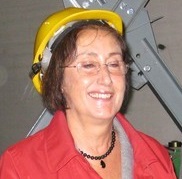A collider is a type of particle accelerator that brings two opposing particle beams together such that the particles collide. Colliders may either be ring accelerators or linear accelerators.

The Budker Institute of Nuclear Physics (BINP) is one of the major centres of advanced study of nuclear physics in Russia. It is located in the Siberian town Akademgorodok, on Academician Lavrentiev Avenue. The institute was founded by Gersh Budker in 1959. Following his death in 1977, the institute was renamed in honour of Budker.

Bruno Touschek was an Austrian physicist, a survivor of the Holocaust, and initiator of research on electron-positron colliders.

Laboratori Nazionali del Gran Sasso (LNGS) is the largest underground research center in the world. Situated below Gran Sasso mountain in Italy, it is well known for particle physics research by the INFN. In addition to a surface portion of the laboratory, there are extensive underground facilities beneath the mountain. The nearest towns are L'Aquila and Teramo. The facility is located about 120 km from Rome.
CEBAF Large Acceptance Spectrometer (CLAS) is a nuclear and particle physics detector located in the experimental Hall B at Jefferson Laboratory in Newport News, Virginia, United States. It is used to study the properties of the nuclear matter by the collaboration of over 200 physicists from many countries all around the world.
ADONE was a high-energy particle collider. It collided electrons with their antiparticles, positrons. It was 105 meters in circumference. It was operated from 1969 to 1993, by the National Institute of Nuclear Physics (INFN) at the Frascati National Laboratory (LNF), in Frascati, Italy.

Borexino is a deep underground particle physics experiment to study low energy (sub-MeV) solar neutrinos. The detector is the world's most radio-pure liquid scintillator calorimeter and is protected by 3,800 meters of water-equivalent depth. The scintillator is pseudocumene and PPO which is held in place by a thin nylon sphere. It is placed within a stainless steel sphere which holds the photomultiplier tubes (PMTs) used as signal detectors and is shielded by a water tank to protect it against external radiation. Outward pointing PMT's look for any outward facing light flashes to tag incoming cosmic muons that manage to penetrate the overburden of the mountain above. Neutrino energy can be determined through the number of photoelectrons measured in the PMT's. While the position can be determined by extrapolating the difference in arrival times of photons at PMT's throughout the chamber.
ADA was one of the first Italian particle accelerators and the first-ever electron–positron particle collider, measuring approximately 1.3 metres in diameter and designed to store beams of 250 MeV.
The WIMP Argon Programme (WARP) is an experiment at Laboratori Nazionali del Gran Sasso, Italy, for the research of cold dark matter. It aims to detect nuclear recoils in liquid argon induced by weakly interacting massive particles (WIMP) through scintillation light; the apparatus can also detect ionization so to exclude interactions of photons and electrons. The experiment is a recognized CERN experiment (RE15).
The DarkSide collaboration is an international affiliation of universities and labs seeking to directly detect dark matter in the form of weakly interacting massive particles (WIMPs). The collaboration is planning, building and operating a series of liquid argon time projection chambers (TPCs) that are employed at the Gran Sasso National Laboratory in Assergi, Italy. The detectors are filled with liquid argon from underground sources in order to exclude the radioactive isotope 39
Ar, which makes up one in every 1015 (quadrillion) atoms in atmospheric argon. The Darkside-10 (DS-10) prototype was tested in 2012, and the Darkside-50 (DS-50) experiment has been operating since 2013. Darkside-20k (DS-20k) with 20 tonnes of liquid argon is being planned as of 2019.
AURIGA is an ultracryogenic resonant bar gravitational wave detector in Italy. It is at the Laboratori Nazionali di Legnaro of the Istituto Nazionale di Fisica Nucleare, near Padova. It is being used for research into gravitational waves and quantum gravity.

The INFN National Laboratory of Frascati (LNF) was founded in 1954 with the objective of furthering particle physics research, and more specifically to host the 1.1 GeV electrosynchrotron, the first accelerator ever built in Italy. The Laboratory later developed the first ever electron-positron collider: from the first prototype AdA, which demonstrated the feasibility, to the ring ADONE and later on to DAΦNE, still operative today (2022). LNF was also the proposed site of the cancelled particle accelerator SuperB.

Giorgio Salvini was an Italian physicist and politician.

Claudio Pellegrini is an Italian/American physics and emeritus professor at University of California, Los Angeles (UCLA), known for his pioneering work on X-ray free electron lasers and collective effects in relativistic particle beams.
Sergio Bertolucci is an Italian particle physicist, and a former director of research and scientific computing at CERN.
Monochromatization in the context of accelerator physics is a theoretical principle used to increase center-of-mass energy resolution in high-luminosity particle collisions. The decrease of the collision energy spread can be accomplished without reducing the inherent energy spread of either of the two colliding beams, introducing opposite correlations between spatial position and energy at the interaction point (IP). In beam-optical terms, this can be accomplished through a non-zero dispersion function for both beams of opposite sign at the IP. The dispersion is determined by the respective lattice.
The Laboratori Nazionali di Legnaro is one of the four major research centers of the Italian National Institute for Nuclear Physics (INFN). The primary focus of research at this laboratory is in the fields of nuclear physics and nuclear astrophysics, where five accelerators are currently used. It is one of the most important facilities in Italy for research in these fields. The main future project of the laboratory is the Selective Production of Exotic Species (SPES), in which various radionuclides will be produced for research and medicinal purposes.
Luisa Cifarelli FInstP is a Professor of Experimental Particle Physics at the University of Bologna. She is the Director of the La Rivista del Nuovo Cimento.

Lucia Votano is an Italian astroparticle physicist, and the first woman to direct the Gran Sasso National Laboratory, from 2009 to 2012. Her research focuses on neutrinos, and she was the coordinator of the OPERA experiment, that led to the first detection of tau neutrinos from muon neutrino oscillation.

Ilan Ben-Zvi is an accelerator physicist and academic. He was the associate chair for accelerator R&D at the Collider-Accelerator Department (C-AD), and is a distinguished scientist emeritus at the Collider-Accelerator Department (C-AD) at Brookhaven National Laboratory.









